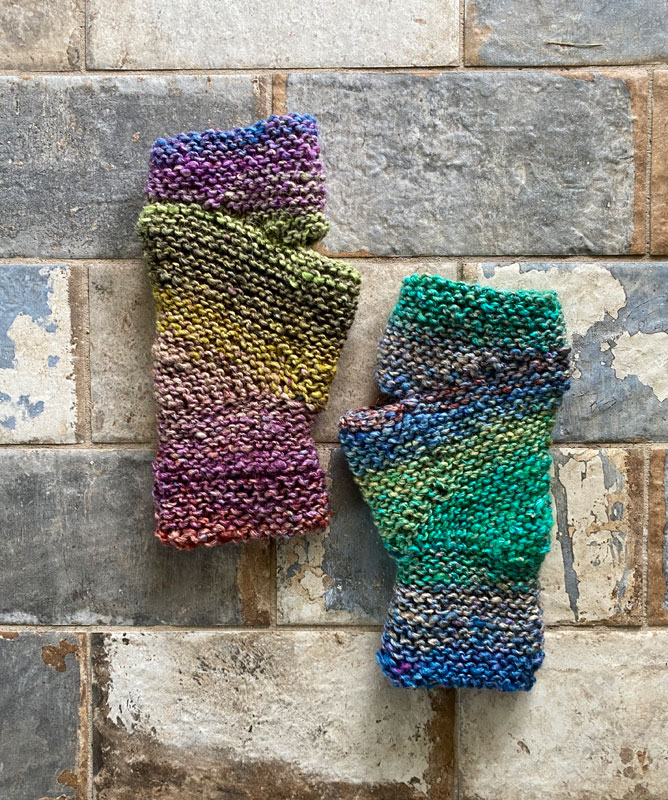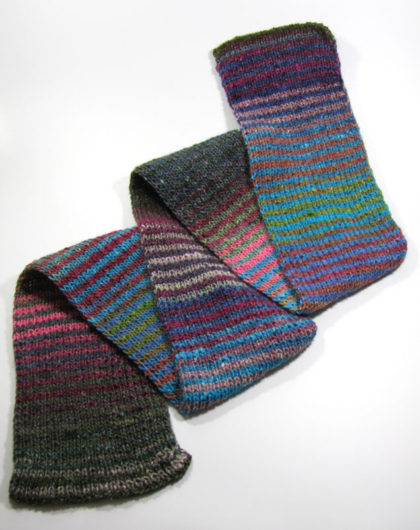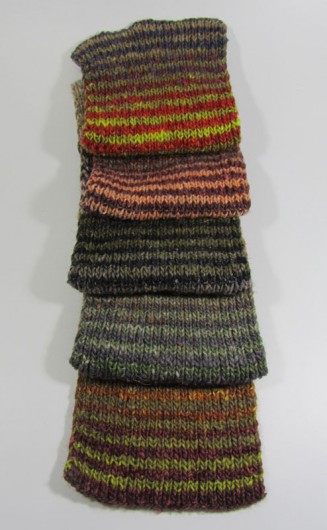
You’ve seen this scarf here before. If you search my blog for Jared Flood Noro Scarf you’ll find them all. All 12 others of them. Flood doesn’t take the credit for this design, but since he’s who wrote a pattern alternating between stripes from different skeins of Noro Silk Garden, I’m completely willing to give him full credit.
You just put your knitting on auto-pilot and let the beautiful Noro Silk Garden do it’s color-changing thing.

People sometimes like the look of the color combination enough to ask me what colorways I used. It’s these two: colorway 423

and colorway 373.

If you’re like me you look at these skeins and then you look at the resultant scarf and it’s hard to see how these skeins turned into this scarf. The magic of Noro. Just go with the flow, including sometimes the lack of flow when you encounter a knot and an abrupt color change. It works out…more or less.
If you’ve one skein of Silk Garden then Laura Aylor’s cute Dust Devils mitts might interest your needles. I actually used 1.15 skeins (57 grams) for mine because I lengthened the wrist and hand sections and widened the cuff. But they’re totally excellent if you decide to follow the pattern exactly.

Here’s another view of the same mitts, flipped over, knit in colorway 494.

This is SUCH a cleverly constructed pattern. They’re worked in the round so no seaming.
The pattern is exactly correct as written. If you think otherwise, respectfully, you’re mistaken. Maybe you miscounted in the short rows or missed or duplicated a row. (I did that a few times and had to rip back to start a section over.)
If you want your mitts to match mine, my modifications will lengthen (and widen) the cast-on and cuff. I cast on and knit the first 10 rounds of the cuff (section 1) in size 8 US needles. Then I moved down to a size 6 for the rest of the cuff and the body of the mitt. I knit 25 (not 18) rounds before working what appears as round 19 in the pattern.
I followed the pattern exactly after that except I also wanted to lengthen the body of the mitt and shape the top a bit more: I worked 11 garter stitch rounds in Section 6. In Round 4 of Section 6 I: K1, K2tog, K15, k2tog, K to the end. In round 10 I: K1, K2tog, K14, K2tog, K to the end. I know. None of that makes a bit of sense unless you’ve got stitches on your needles and are working the pattern.
I don’t want to offer so many tips that I make this pattern sound difficult. Because it isn’t. It’s just garter stitch and short rows. But. If you’re using doublepoints you’ll avoid holes by keeping the fabric from being stressed at the turns. That’s accomplished by redistributing the stitches more evenly on the needles. And in Section 4 at Round 16 the stitch count works by purling 15, then working the 14 bind-off stitches without disturbing the first 15 stitches. In other words, don’t use the 15th stitch as part of your bind-off.
All right. Too much hand holding. Here’s my second pair:

Now, flipped over to see more about how this colorway 213 worked out.

Some knitters’ Ravelry project pages are stressing about right side/wrong side. Honestly, I don’t get that. There’s so much going on with these colors and knitting switchbacks that I don’t see how that matters. They work well on hands. And each hand can wear either mitten.

These proved very interesting to my knitworthies who are younger than me and more hip. Gosh. Sort of everyone is younger and more hip than me.


















